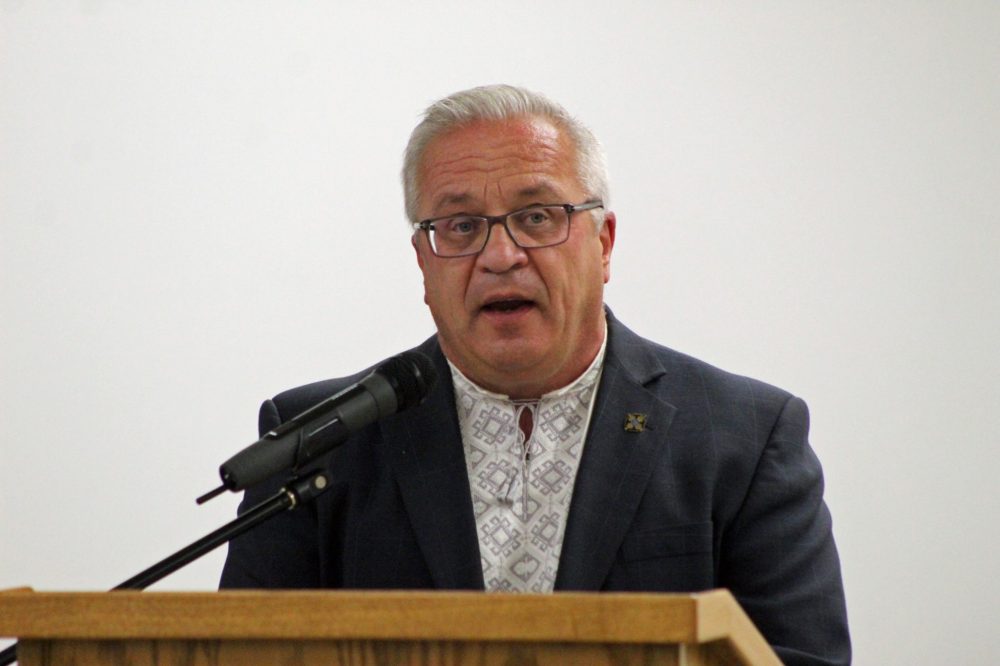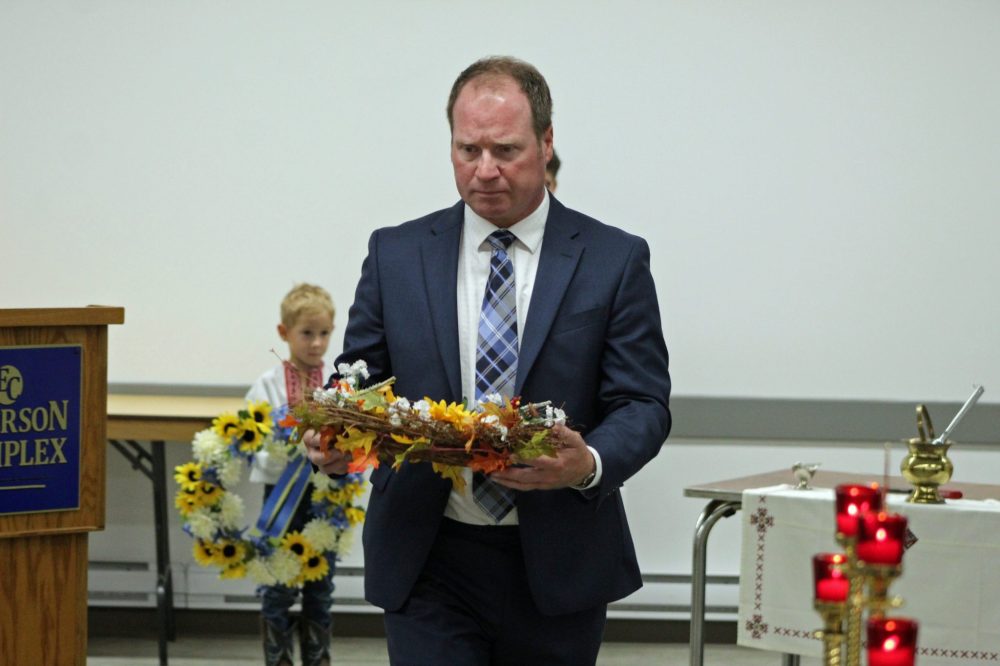Emerson exhibit recalls 1915 border arrests, internment
Advertisement
Hey there, time traveller!
This article was published 25/09/2022 (947 days ago), so information in it may no longer be current.
A dark and little-known chapter of Canadian history is the subject of a new permanent outdoor exhibit unveiled Saturday in Emerson.
Roughly 75 people filed into the Emerson Complex for an hour-long opening ceremony for the exhibit, which consists of a three-sided freestanding monument and a large interpretive panel that will be installed in Emerson Corner Park.
Present for the ceremony were elected officials from all three levels of government, representatives from three national Ukrainian organizations, several Ukrainian religious leaders, and 14 Ukrainian newcomers.

The exhibit explores Emerson’s connection to Canada’s national internment operations during the First World War. Between 1914 and 1920, 8,500 people were forced into hard labour at two dozen internment camps scattered from British Columbia to Nova Scotia. They built roads, cleared bush, and cut trails. Some were “paroled” to farms, mines, or railways to alleviate a wartime labour shortage.
Seventy percent of those interned were Ukrainian immigrants whom the federal government considered “enemy aliens” under the War Measures Act because they came from the provinces of Bukovyna or Galicia, then provinces of the Austro-Hungarian Empire with which Canada was at war.
Austrians, Bulgarians, Croatians, Czechs, Germans, Hungarians, Italians, Jews, Poles, Romanians, Serbians, Slovaks, and Slovenes were also interned. Some internees tried to escape, while others resisted through work slowdowns and riots.
According to research by the Manitoba Museum, unemployment was the most common reason for internment. Some were arrested for being unreliable, not carrying the correct papers, or acting suspiciously. Personal wealth and property were confiscated and some of it was never returned.
Another 80,000 people were forced to register with authorities. Some, like the grandparents of Selkirk—Interlake—Eastman MP James Bezan, who attended Saturday’s ceremony, had to travel long distances to report weekly to the RCMP. Others faced general restrictions on their freedoms of movement, speech, and association.
By the time the last camp shut down, two years after the war ended, 170 internees had died in captivity. Many were buried in unmarked graves. The last known survivor of the camps died in 2008.
Manitoba was home to an interment camp in Brandon and a receiving station in Winnipeg that processed and held those awaiting internment.
The exhibit chronicles arrests made in Emerson in May 1915, when a group of 1,000 men set out on foot from Winnipeg in the hopes of finding work in the United States. Two days later, after many had turned back, 200 tired and hungry men arrived in Emerson. The town fed and sheltered them before turning them over to law enforcement. The men were loaded onto a train and taken to Brandon, where they laboured until July 1916, when the camp closed.
Emerson-Franklin reeve Dave Carlson called the arrests and detention “a grave injustice.” He said the new exhibit, which includes black-and-white photographs of the men in Emerson, is a reminder of the past and a warning for the future.

Borys Sydoruk, chair of the Ukrainian Canadian Civil Liberties Foundation’s internment committee, travelled from Calgary for the ceremony. The UCCLF worked with the RM of Emerson-Franklin’s tourism committee to create the exhibit, which was supported by the Canadian First World War Internment Recognition Fund, a $10 million endowment for memorial and education projects established in 2009.
“The exhibit will educate as well as emotionally remind visitors to the park what happened in Canada a century ago, to minorities like Ukrainians and others, when the government implemented laws based on fear and hysteria and directed it at specific ethnic groups,” Sydoruk said.
He noted no evidence of disloyalty on the part of internees was ever discovered. Many had been enticed to emigrate to Canada in the decades before the war. Between 1891 and 1914, about 170,000 Ukrainian immigrants arrived in Canada, many lured by the promise of free land.
Jo-Anne Drewniak, a member of Emerson-Franklin’s tourism committee, said research for the exhibit began seven years ago, when a historian from Queen’s University in Kingston, Ont. emailed the committee asking about the arrests.
“We all looked at each other and thought, ‘What is this about?’ Nobody knew,” Drewniak said.
Soon committee members were delving into letters and photographs housed at the Manitoba Museum.
Speeches at Saturday’s ceremony dwelled on how few Canadians today know about their country’s interment operations during First World War. Sydoruk admitted he knew nothing of them until 1989. His committee has been placing monuments and plaques across Canada since 1994.
Provencher MP Ted Falk, whose grandparents emigrated from Ukraine in the 1920s, condemned the internments but urged forgiveness for those who carried them out.

“I like to think that, at that time, in their context, they actually believed they were doing the best thing for Canada,” Falk said. “With the benefit of hindsight, we can say absolutely not—that was wrong. But how many things do we see government and society doing that today our children, and our grandchildren, will say, ‘Hey, what happened back there was wrong.’”
Following speeches, Carlson and others laid wreaths at the foot of the monument, which features text in three languages.
Earlier in the ceremony, incense and singing filled the room as the monument was consecrated by Fr. Roman Bozyk, dean of theology at St Andrew’s College in Winnipeg, and Fr. Mykhaylo Khomitskyy of St Basil the Great Ukrainian Catholic Church in Winnipeg.
Saturday’s ceremony took place against the backdrop of irregular asylum crossings from the United States that have put Emerson the international spotlight over the last five years. In January, a family of four from India was found dead of exposure to cold in a field west of Emerson.
“There’s definitely parallels there,” Carlson said after the ceremony. “This is a major international border crossing and it seems as though it’s a real lightning rod for folks crossing.”
